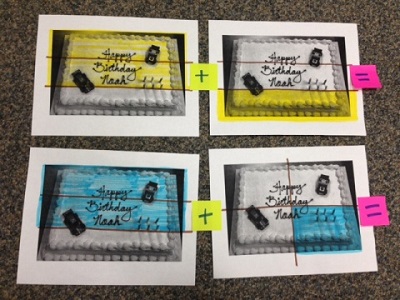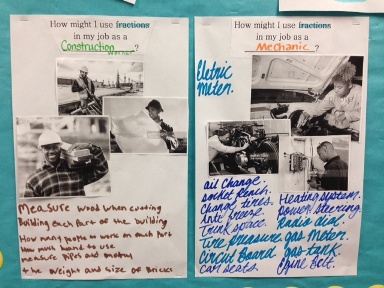- MN ABE Connect
- Archive
- Conceptual Understanding in Instruction: It Really Works!
Conceptual Understanding in Instruction: It Really Works!
Molley Bruce, InstructorThe week after attending the ATLAS Math Institute for the second time, I began planning a mini-lesson on adding and subtracting fractions. I considered my students’ learning preferences, and yet I reverted to beginning the instructional delivery with the process; this was how I was taught. However, the Math Institute presenters, Cynthia Bell and Libby Serkies, reminded us about the importance of conceptual understanding. My co-teacher, Abby Roza, and I quickly began to modify the lesson plan to first begin with helping our students understand the reason why we perform the math operations that we do in order to add and subtract fractions.
 I began with a Circle Map to assess what our students already knew about fractions. Instead of proceeding with lecture and the students taking notes on the procedural steps for finding the lowest common denominator, the activities were flip-flopped to begin the instructional delivery with images of a birthday cake.
I began with a Circle Map to assess what our students already knew about fractions. Instead of proceeding with lecture and the students taking notes on the procedural steps for finding the lowest common denominator, the activities were flip-flopped to begin the instructional delivery with images of a birthday cake.
First they were shown a whole cake, then half. When asked what the picture displayed, the students answered “half.” The fraction indicating half was written on the board: ½. Analysis level questioning was used to allow students to expand on what the 1 and 2 meant in relationship to the fraction.
The lesson progressed to include visuals of cakes with like-sized portions (denominators) and then, different serving sizes (unlike denominators). The students authentically reached their own discovery that one must make things alike in order to add them. Because we had begun with guiding the students to conceptual understanding, the instructional delivery of the steps was almost nonessential.
The reward for me as a teacher was when I took a step back during the independent practice, caught a moment of eye-contact with my co-teacher, and we realized that the students were engaged in academic momentum and rich mathematical conversation without our external support. They discussed the problems and self-corrected with sketches or visuals.
 Closure to the activity included a think-pair-share with posters of different professions and how those trades or careers use fractions. The intention was to help students see how the math applies to a work-related context (e.g., how fractions are used in specific trades or jobs, modification of recipes from bulk quantities to family size, fractional math needed for construction work or home repairs). This occurred within the greater context of the full lesson, which drew on the content standards and mathematical practices outlined in the College & Career Readiness Standards (CCRS).
Closure to the activity included a think-pair-share with posters of different professions and how those trades or careers use fractions. The intention was to help students see how the math applies to a work-related context (e.g., how fractions are used in specific trades or jobs, modification of recipes from bulk quantities to family size, fractional math needed for construction work or home repairs). This occurred within the greater context of the full lesson, which drew on the content standards and mathematical practices outlined in the College & Career Readiness Standards (CCRS).
Thank you to ATLAS Math Institute, Cynthia, Libby and the other teachers at the event for inspiring meaningful learning and delivery of instruction – especially for the students that I serve whose past educational experiences were repeatedly interrupted, inconsistent or unfulfilling. It was such a joy to observe them enjoying a math lesson. Because, we all want a piece of the cake…and the same size as our peers…right?
Newsletter Signup
Get MN ABE Connect—the official source for ABE events, activities, and resources!
Sign UpArticle Categories
- ABE Foundations/Staff Onboarding
- ACES/Transitions
- Adult Career Pathways
- Assessment
- CCR Standards
- Citizenship
- COVID-19
- Cultural Competency
- Digital Literacy/Northstar
- Disabilities
- Distance Learning/Education
- ELA
- Equity/Inclusion
- ESL
- HSE/Adult Diploma
- Listening
- Math/Numeracy
- Mental Health
- Minnesota ABE
- One-Room Schoolhouse/Multilevel
- Professional Development
- Program Management
- Reading
- Remote Instruction
- Science
- Social Studies
- Speaking/Conversation
- Support Services
- Teaching Strategies
- Technology
- Uncategorized
- Volunteers/Tutors
- Writing